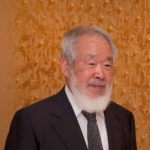Background
Kim was born in Maengsan, South P'yŏngan province, North Korea, on December 24, 1929.

Peter Femfert meets Kim Tschang Yeul at Korea International Art Fair.
Kim Tschang Yeul, his wife and the VIP’s cut the ribbon during the opening of his museum.
Kim Tschang-Yeul painting.
Kim Tschang-Yeul with his work.
Photography of Kim Tschang-Yeul.
1 Gwanak-ro, Gwanak-gu, Seoul, South Korea
Seoul National University
215 W 57th St, New York, New York 10019, United States
The Art Students League of New York










Kim was born in Maengsan, South P'yŏngan province, North Korea, on December 24, 1929.
After studying painting at the College of Fine Arts at Seoul National University from 1948 to 1950, he moved to the United States and studied printing at the New York Art Student League between 1966 and 1968.
Kim lived most of his adult life in Paris, France, where he created most of his paintings and developed his own artistic style. Since 1950 Kim became the leader of the Korean Art Informel movement, which he organized along with Park Seo-Bo, Se-Ok Suh, Ha Chong-Hyun, and Chung Chang-Sup in the 1950s and 60s. Their movement was a huge inspiration for many avant-garde artists of the following generation. They rejected the conservative values imposed on them by Korean institutions.
In 1961 he participated in the Paris Biennale, a noted French art festival, and in 1965 in the São Paulo Biennale, the second oldest art biennial in the world after the Venice Biennale. After his exhibions he moved to New York and during his stay there he was impressed by the Pop art movement, which had a significant impact on him. In 1969 Kim Tschang-Yeul moved from New York City to Paris, where he depicted dense abstract liquid forms. With the lapse of time, his liquid abstract forms transformed into spherical, transparent "water drops". They have become the basis for his distinctive, unique and trademark style in the mid-1970s.
In the 1980s, Kim devoted most of his time to reading and practicing writing. He decided to draw positive texts from Thousand Character Classic or deconstruct Chinese letters to compose together with water drops and created the new series Recurrence. This series was a struggle over the reality and illusion of time and space. At the beginning of the 1990s, Kim Tschang-Yeul started to paint water drops on wooden boards and newspapers, exploring new media and techniques for his works. Concurrently, he also made several works in sculpture, with iron, bronze, or rock using as the base, and with glass for water drops as the installation.
Kim Tschang-Yeul’s style is the mixture photorealism and abstract expressionism. His works combine both features of reality and the abstractionism. The artist interprets his subject not as realistic depictions of actual water drops, but "idealistic" ones. Moreover, he explains that painting water drops helps him erase painful and traumatic memories of his service during the Korean War between 1950 and 1953, where he witnessed the deaths of his fellow soldiers.
The artist's artworks have been extensively exhibited: solo exhibition at the Staempfli Gallery New York, and at the Gallery Takagi, Nagoya, Japan in 1978; at the Tate Gallery, Liverpool, United Kingdom in 1992; at the Andrew Shire Gallery, Los Angeles, California, United States in 1999; Kim Tschang-Yeul Selected Exhibitions in 2005 in Korea, China and France, in 2008 in Korea, United States, France and Singapore, in 2014 at the Jeju Museum of Art, Gwangju Museum of Art, Seoul Museum, all located in Korea.
Kim lives and works between Seoul, South Korea and Paris, France. His works are held in the collections of the Albright-Knox Gallery in Buffalo, the Hirshhorn Museum and Sculpture Garden in Washington, D.C., the Seoul Museum of Art, and the National Museum of Modern Art in Tokyo, etc.

Kim Tschang-Yeul is a prolific painter, who is well known for his "water drop" paintings. He is definitely one of the most influential figures in modern Korean art history. Kim Tschang-Yeul is considered the artist who inspired monochromatic painting in Korea, as well as one of the most influential Korean masters in contemporary art in the W.
In order to commemorate his distinguished artistic career, the government of Korea opened the Kim Tschang Yeul Museum of Art in Jeju, Jejudo Island, South Korea, in 2016. It has been the highest honor bestowed upon a living Korean artist. Many Kim Tschang-Yeul's works have been sold at auction, including Gouttes d'eau sold at Korea Premier Auction "K Auction 2016 May Hong Kong Sale" in 2016 for $2,300,000.
In 2017 he received the Officier medal of the Ordre des Arts et des Lettres from the Embassy of France in Seoul, Korea.
Untitled
Récurrence
Neige
Waterdrops No. 10
Récurrence
Gouttes sur papier journal
PA93020
Récurrence
Gouttes
Untitled
Nuit
Récurrence
Water Droplets
Gouttes
Water drops
PA 7901
Recurrence SB05005
Recurrence SH2012011
Untitled
Waterdrops
Waterdrops
Waterdrops P.A.85009
Water Drops, from The Official Arts Portfolio of the XXIVth Olympiad, Seoul, Korea
Water Drops
Waterdrops
Waterdrops S.H 86013
Recurrence
Recurrence SP201202
Recurrence SPD201506
Quotations:
"The famous monk Dharma meditated for nine years to achieve spiritual enlightenment, I have been painting water drops for 40 years but wasn't able to reach Dharma's level of enlightenment."
"The process of painting the water drops is to filter, to dissolve all the impurities out of them and return them to a clear state of nothing. When all the rage, anxiety, and fear come to the moment of nothing, we reach a state of peace and comfort."
